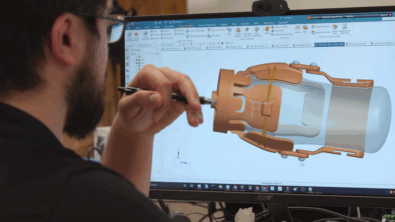Navigating supply chain disruptions in A&D with digital transformation

Supply chain disruptions have long been the source of many frustrations in the aerospace and defense (A&D) industry. They have hampered the development of aircraft and spacecraft for decades and have only gotten worse with major events like the COVID-19 pandemic. Even as the world recuperates from the pandemic, supply chain delays are still forecasted to be a major thorn in A&D companies’ sides. A targetable cause behind many of these disruptions, however, is the lack of transparency and integration between supply chain data and the rest of the design process, which can be alleviated with help from digital transformation.
Supply chains and the design process
A lot of supply chains today have grown to the point where they are too large and unpredictable for A&D companies to simply track and manage their processes like they used to. Many original equipment manufacturers (OEMs) and some Tier 1 suppliers manage networks connecting thousands of organizations. Issues are bound to rise in networks so large, ranging from localized material shortages to disruptions in global shipping routes. All the while, engineers in the design process are unable to access all the data that could inform them of these obstacles.
This spells poorly for A&D programs, as companies are constantly under pressure to achieve faster times to market while cutting costs, both of which can be easily derailed when supply chains go awry. For example, an engineer might order a crucial component from a supplier with a lead time of fifteen weeks, only to find a month later that the lead time increased to eighty weeks after a factory malfunction. The engineer is left to either wait for the extended time or search for an alternate supplier, which not only costs more money and carries the same risk, but can also push the program past deadlines set by a client. Without adequate supply chain data, disruptions like these become common throughout the industry.
Additionally, the delivery of physical parts does not guarantee they will end up conforming to the product’s design. According to a study by Lifecycle Insights on Verification Management in Aerospace and Defense, 40% of A&D programs frequently find that physical parts do not conform to the digital design of their products. Supply chains can contribute to this issue, whether from an error in sourcing the right part or from damage during transit. In any case, when these situations arise, engineers find they need to redesign or start over entirely, resulting in a need for new parts and risking further delays in the supply chain. Once again, these are issues that could be solved with transparent access to supply chain data.
Digitalizing the supply chain
Since traditional methods of tracking supply chains are no longer optimal, digital transformation is being explored as a possible solution. Companies can construct a supply chain digital twin, a virtual representation of a supply chain that can integrate data such as component lead times, availability, pricing, obsolescence, and carbon impact. This grants a new level of transparency and insight into supply chains, which engineers can then use to determine which parts to use in their designs earlier with extra confidence in their suppliers.
Additionally, other aspects of digital transformation like AI and machine learning can be used to make supply chains more agile and flexible. Data-gathering algorithms can be used in concert with the supply chain digital twin to automatically aggregate the aforementioned data on suppliers and more, allowing engineers to incorporate factors like material shortages and potential economic downturns into their decision-making processes. They also have the added benefit of shifting the responsibility of gathering data away from engineers, giving them more time to work on other important tasks. With this open access to information, A&D companies can better optimize their supply chains and work around disruptions.
Opening the future
The existence of supply chain disruptions in A&D will not disappear any time soon, but that does not mean companies cannot take steps toward alleviating them. By implementing technologies like the digital twin and AI/ML, companies can integrate immense amounts of supply chain data into their design processes to analyze the risks in their supply chains and optimize them earlier in product lifecycles. With enough time investment, digital transformation can help A&D companies open the bottlenecks that have kept too many aircraft and spacecraft grounded.
Siemens Digital Industries Software helps organizations of all sizes digitally transform using software, hardware and services from the Siemens Xcelerator business platform. Siemens’ software and the comprehensive digital twin enable companies to optimize their design, engineering and manufacturing processes to turn today’s ideas into the sustainable products of the future. From chips to entire systems, from product to process, across all industries, Siemens Digital Industries Software is where today meets tomorrow.


